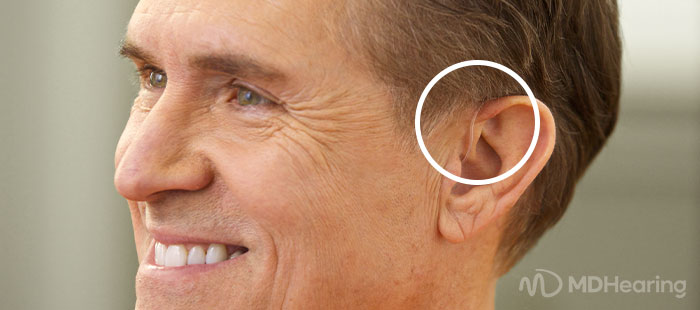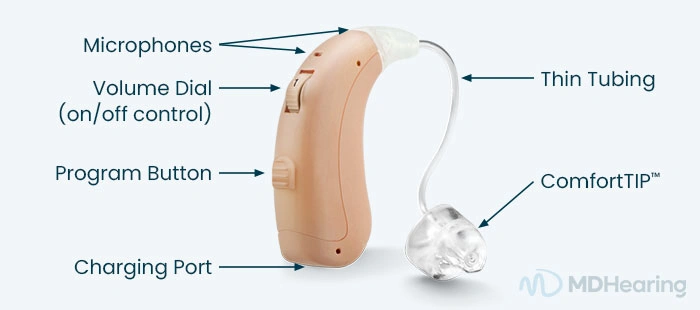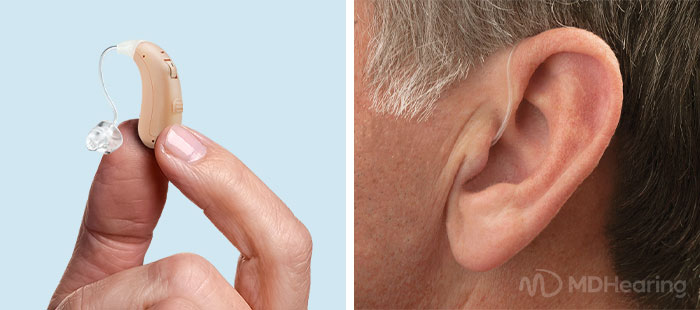Behind-the-ear hearing aids offer distinct advantages that other hearing aid styles cannot provide. Whether you want better technology, more sound amplification, longer battery life, greater comfort, or a more affordable price tag—BTE hearing aids are a clear and practical choice.
Want to know the truth about BTE hearing aids? In this article, we’ll explore the defining features of BTE hearing aids, how they’re built, and why we feel they are the best hearing aid style on the market.
What Makes BTE Hearing Aids Unique?
Behind-the-ear hearing aids come in all different shapes and sizes. Some are extremely small and virtually invisible—especially when your hair covers the back of your ears—while others are larger to accommodate the bigger and more powerful components required for certain features.
As for their build, BTE hearing aids have a small, curved casing that sits comfortably behind your ear. Inside the casing is all of the functional electronics of the BTE hearing aid. Even the speaker—which channels sound into the ear through a clear plastic tube and tip—is located in the device itself.
The clear plastic tubing that goes over your ear is the defining feature of BTE hearing aids. It connects into a tip that fits snuggly in the ear canal. Unlike a receiver-in-the-canal (RIC) hearing aid (which has a tiny speaker in the tip), the tube and tip of a BTE do not contain any electrical components. They simply provide an air-channel that the hearing aid sounds travel through into your ear.
BTE hearing aids from MDHearing come assembled with “ComfortTIPs”, which are silicone tips uniquely designed to fit comfortably in the majority of ear canals. MDHearing also offers different sizes of soft ear domes if the ComfortTIPs don't work for you. Both the ear domes and ComfortTIPs offer a snug, custom feel without any office appointments or in-person fittings required.
If an even more precise fit is desired or required, BTEs can usually be fitted with a custom ear mold that fits the unique contours of your ear canal. These can be obtained from an online store or from a local audiologist or hearing aid dispenser.
Compared to in-the-ear hearing aids like the NEO (which fit entirely in the ear canal or bowl of your ear), BTEs are larger. This gives them extra space for components that can provide more advanced features, such as more powerful speakers to treat individuals with more severe hearing loss and extra microphones for more clarity in environments with background noise. Finally, the larger size of BTEs gives them room for longer-lasting batteries, so you don’t have to replace/recharge your hearing aid batteries as often.
Let’s summarize what makes BTE hearing aids unique. Key points in this section:
-
The entire aid and all of its components rest behind the ear.
-
A clear tube goes over the ear and channels sound into the ear canal.
-
Large enough to fit advanced components and larger batteries for improved performance.
-
Can treat the widest range of hearing loss conditions, including profound hearing loss.
-
Easy to put on, take off, and adjust the settings.
Behind-the-Ear Hearing Aid Components
Most BTE hearing aids consist of the following functional components:
-
Microphones: The microphone captures sounds and turns them into electronic sound signals. Many BTE hearing aids include multiple microphone ports, which allows the hearing aid to focus on sound coming from a specific location.
-
Amplifier: The amplifier takes the sound signals from the microphone and raises and lowers different frequencies, tuning the sound in a way that helps you hear more clearly.
-
Processor: The processor is a tiny computer chip that controls the hearing aid and its amplifier, allows you to adjust settings, and tunes sound according to your hearing loss profile.
-
Speaker (Receiver): The speaker (also called the “receiver”) turns the digital sound signals from the amplifier into audible sounds for your ear.
-
Volume and settings controls: Many BTE hearing aids include simple volume and/or program controls that let you adjust the sound of your hearing aids.
-
Battery: Whether it’s rechargeable or disposable, the hearing aid battery sends power to the hearing aid. Rechargeable batteries usually need to be charged once per day, and disposable batteries tend to last a week or longer.
-
Thin tubing: The thin tubing is a clear plastic tube that travels over the ear and creates an air-channel to transport sounds from the hearing aid to the ear.
-
Tip: Whether a ComfortTIP, dome, or custom ear mold, the tip connects to the end of the thin tubing and inserts into the ear canal to deliver sound to the ear.
Here’s a diagram of the VOLT hearing aid from MDHearing:
Does Hearing Aid Size Matter?
Building better, more powerful versions of the above components is a primary focus of the hearing aid industry. Making them smaller and smaller is another important focus. However, the smaller your hearing aids get, the smaller the components need to be—and this makes smaller hearing aids more expensive and harder to handle. Extra-mini, invisible-in-the-canal (IIC) and completely-in-the-canal (CIC) hearing aids (like Eargo) may have to sacrifice advanced tech features and hearing treatment quality on the journey to micronization.
At the end of the day, you can pay thousands of dollars extra just to shave a few millimeters off the size of the device. If you are choosing IIC or CIC hearing aids, you could be losing out on important tech features. This begs the question: Is paying extra for a smaller hearing aid worth it?
At MDHearing, our BTE hearing aids are still small and discreet. At the same time, we have found a more economical and practical balance between size and superior hearing treatment for a fraction of the price of traditional hearing aids. By choosing this ideal size, we have room to fit advanced technology in an FDA-registered hearing aid product—while saving our customers thousands of dollars per ear.
As you can see in these photos, MDHearings are still tiny and difficult to detect:
The Advantages of BTE Hearing Aids
Let’s review the distinct advantages of BTE hearing aids over other styles:
1. More Room to Fit Technology and Advanced Features
Since BTE hearing aids rest behind the ear, there’s a lot more room to include additional tech features. For example, if you want to equip the hearing aid with Bluetooth connectivity, extra microphones, and a powerful processor, it’s easier to do so in a BTE hearing aid than it is in an ITE (in-the-ear) hearing aid where space is limited.
2. Less Expensive
The smaller tech required by smaller hearing aids is more expensive than larger versions of the same technology—and in many cases, smaller ITE (in-the-ear) devices can’t accommodate the most advanced technology. Even if such a device offers comparable tech, is spending thousands of dollars extra worth it to have a device that is just millimeters smaller?
3. More Powerful Speakers (Receivers)
The larger size of BTEs offers more space for a bigger, more powerful speaker (also referred to as “receivers”). This is why hearing aids for individuals with profound hearing loss are often BTE models.
4. Longer-Lasting Batteries
BTE hearing aids can fit larger batteries that last longer—so you won’t have to replace/recharge your batteries as often. More powerful batteries also provide the extra juice required for greater sound amplification.
5. Easier to Clean and Maintain
BTE hearing aids are easy to clean and maintain. For one, all of the electronic components and microphone ports are behind the ears, where they are more protected from contamination by earwax build-up, dirt, and debris. This helps the hearing aids last longer and means the receiver and microphone ports are less likely to get clogged with earwax and dirt. As for the clear tubing, this is easy to clean with the wire cleaning tool that comes standard with BTE-style devices.
Learn more about cleaning your hearing aids here!
6. Comfortable to Wear
BTE hearing aids are still extremely small, lightweight, and comfortable to wear. Also, because the entire device does not insert into your ear, you may find them a lot more comfortable than in-the-ear hearing aid models.
MDHearing: Quality, Medical-Grade BTE Hearing Aids for Less
At MDHearing, we design, manufacture, and sell high-quality, FDA-registered BTE hearing aids for a fraction of the cost of hearing aids you’ll find at hearing clinics. We keep your costs down by shipping our OTC hearing aids directly to your door from our facility in Chicago—without any appointments or hearing clinic visits required. This allows you to bypass the exorbitant markups of hearing clinics and traditional hearing aid manufacturers while saving thousands of dollars per ear.
Starting at $299.98 per pair, you can try MDHearing risk-free. Every MDHearing product comes with a 100% money-back guarantee, so if you don’t like your hearing aids, you can send them back for a full refund. Order now, and you’ll have your hearing aids in just a few days!
Learn more about our line of discreet and comfortable BTE hearing aids.
BROWSE HEARING AIDS



